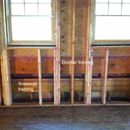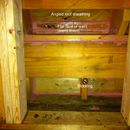Kneewall insulation question
I have been diligently air sealing the home we are building. Extreme air sealing probably, but that’s ok – the only time it is taking is mine and I don’t really cost me any money.
I am getting much closer to actually insulating the home with dense-packed cellulose behind a smart membrane (Intello Plus, in this case) and I have a few questions about some tricky areas. I’ve got some photos and will try to explain the situation adequately.
This first photo shows the framing of the front wall of the shed dormer. It is about 8 inches away from the kneewall framing. The second photo shows the real problem – how to insulate this area of the wall – framing of the kneewall behind the dormer wall.
All of the outside walls are taped. I’m using Prosoco Joint and Seam Filler inside just to make sure all air leaks are closed up.
The options are:
1. Staple the smart membrane in place on the kneewall framing- dense-pack cellulose that area, followed by dense-pack cellulose of the dormer wall.
2. Insulate with available batt insulation – I have some Roxul Comfort batts left over from prior insulation work, then staple membrane in place, then dense pack the dormer framing.
3. Use dense pack cellulose over the whole thing with only one layer of the smart membrane on the interior surface of the dormer framing.
I’m not sure how experienced the insulation guys are at serious dense-packing cellulose so I actually prefer option number 2. I know that I will fill this awkward space completely with insulation.
What do you think?
GBA Detail Library
A collection of one thousand construction details organized by climate and house part











Replies
Lucy,
It's hard to tell if there are any invisible nooks and crannies in this space. But I think you understand what is required: you need a good air barrier to be sure that there is no air flow through the assembly, and all nooks and crannies need to be filled with insulation.
Blown-in cellulose usually does a better job of filling nooks and crannies than batts. But if you take your time and do a conscientious job, batts can work. You just have to understand the shape of the cavity you are filling, and do your best to cut the batts to fit.
Still, I'm not sure why you wouldn't prefer to use dense-packed cellulose.
Martin,
There are lots of nooks and crannies in this area. That's exactly my concern about having someone blow in cellulose. Also since the people who do the work around here tend not to speak English, I have even less confidence in my ability to communicate the importance of filling every nook and cranny.
I think the air barrier situation is covered - taped well on the outside sheathing and the smart membrane on the inside after the batt insulation installed.
Thank you once again, Martin, for your early morning advice.